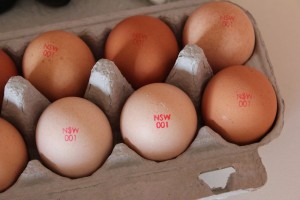Friend of the barfblog and current Welsh tourist, Don Schaffner of Rutgers University, has a few things to say about egg safety, especially: most of those so-called tests are BS.
 According to SafeBee, there are lots of egg tests on the Internet. You’re supposed to place an egg in a bowl of cold water, for instance. If it floats, it’s old. If it sinks, it’s fresh. If it sinks but stands on its pointed end, it’s supposedly a caution: eat it now before it goes bad.
According to SafeBee, there are lots of egg tests on the Internet. You’re supposed to place an egg in a bowl of cold water, for instance. If it floats, it’s old. If it sinks, it’s fresh. If it sinks but stands on its pointed end, it’s supposedly a caution: eat it now before it goes bad.
The theory behind the float test? Egg shells are porous, and as time goes on the egg’s liquid evaporates through the porous shell and air enters. That makes the eggs more buoyant, so some say the older an egg, the more it floats.
Forget this test, says Don Schaffner, PhD, a food scientist at Rutgers the State University of New Jersey. “Eggs do take in air as they age, but the size of the air cell in the egg varies from egg to egg. So a freshly laid egg and an older egg may react similarly.” There is too much variability in air cell size from egg to egg to make this a valid test, he says.
Other Internet advice calls for cracking the egg open and inspecting the yolk and albumen (the white part). If it’s a fresh egg, the yolk should be bright yellow or orange, and the white should not spread much.
Schaffner gives a thumbs-down to this test as well. “The color of the yolk is primarily determined by what they feed the chickens,” he says. “It may change over time, but it will vary from egg to egg.”
As for the white part: “An older egg will have a white that spreads more than a fresher egg,” he says. “But that has nothing to do with the fact that the egg is spoiled or not, it’s a chemical, physical change in the egg.”
Another popular idea is to give your egg the sound test. In a quiet space, hold the egg up to your ear and shake it. If it sloshes, the egg has gone bad, the story goes. That sloshing is said to indicate a watery, old yolk.
Shaffner says this sound test has no credibility. “Eggs do slosh around,” he says. Sloshing doesn’t indicate spoilage, however, he says. He does have another use for the sound test: “That would be a good way to see if the egg is hardboiled or not.”
 The best test to see if an egg is OK to eat? Get the egg in question and have your nose ready. “As far as I know the only way to know an egg is bad is to crack it open and see if it smells.” Of course, you can always examine the egg as you smell, he says. “If it looks strange, I wouldn’t consume it, but odor is the real tip off.”
The best test to see if an egg is OK to eat? Get the egg in question and have your nose ready. “As far as I know the only way to know an egg is bad is to crack it open and see if it smells.” Of course, you can always examine the egg as you smell, he says. “If it looks strange, I wouldn’t consume it, but odor is the real tip off.”
Never mind that your refrigerator has a special spot for eggs built into the door. Keep them in the carton, Schaffner and others say. “We know the door is not as good,” he says.
Instead, put the eggs, still in the carton, in the coldest part of the refrigerator. On the door, the temperatures may fluctuate when the door is opened and closed. Keeping the eggs in the carton also means you can refer to the sell-by date. Eggs — even hard-boiled eggs — should not be left out at room temperature more than two hours, as dangerous bacteria can grow.
“Salmonella is the organism we are most worried about,” Schaffner says. It could be inside the egg if it was infected before it was laid, or it could be on the shell.
Cook whole eggs to about 144 to 158 degrees F; egg whites, 144 to 149; yolks, 149 to 158. Cooking eggs sunny side up or over easy is more of a Salmonella risk than cooking them more thoroughly, Schaffner says.
